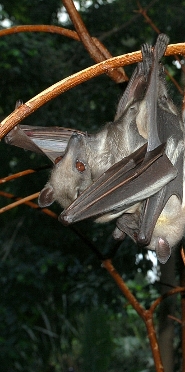 Bats are crucial in our ecosystem because they pollinate plants and distribute ingested seeds as they fly and their bat droppings include bacteria useful in detoxifying wastes. The straw-colored fruit bat (Eidolon helvum) is the second largest fruit bat on the African continent. Their origin is in Africa, mostly in tropical forests, but they are disbursed throughout the world.
Bats are crucial in our ecosystem because they pollinate plants and distribute ingested seeds as they fly and their bat droppings include bacteria useful in detoxifying wastes. The straw-colored fruit bat (Eidolon helvum) is the second largest fruit bat on the African continent. Their origin is in Africa, mostly in tropical forests, but they are disbursed throughout the world.They are a large species of bat with a yellowish brown on top and olive colored underneath, their cheeks are large and formed like pouches, with wings tapered at the tips. The males have black wings and an orange colored ruff. They like to live in forests, especially with tall trees. They have large eyes, adapted for night vision, along with large ears. Their body is around 215 mm, or 5 to 9 inches, and its wing span is 762 mm, or up to 30 inches. Females are larger than males, a full grown adult straw-colored fruit bat weighs around 300 grams, or 8 to 12 ounces.
They have very strong wings and can fly up to 125 miles (200 kilometers) while looking for fruit, nectar, or vegetables, or bark, since they like to gnaw on bark. They locate their food by sight and smell at night but prefer to stay in trees during the day. Every year bats return to the same place that they found food the year before.
These bats are very social bats and stay in huge colonies ranging from one hundred thousand to one million bats, both male and female included, and during migration their numbers are higher. Since they live in tight knit communities but are suspicious of outsiders, they are one of the most secretive specie of bat, preferring to keep their colonies and hide out. These bats can live over twenty years.
The largest danger and predator of straw-colored fruit bats are humans. In some areas, such as West Africa, straw-colored fruit bats are hunted and consumed for their meat because they are considered a delicacy. It is believed in Africa that eating straw-colored fruit bats will increase a woman's fertility. Elsewhere they are killed by farmers, because they are considered pests.
Picture of the Straw-colored fruit bat by Fritz Geller-Grimm, licensed under the Creative Commons Attribution-Share Alike 2.5 Generic license.
Keywords: brown
The Straw-coloured fruit bat is listed as Least Concern. Does not qualify for a more at risk category. Widespread and abundant taxa are included in this category, on the IUCN Red List of Threatened Species
Namings for the strawcolored fruit bat
A young / baby of a strawcolored fruit bat is called a 'pup'. A strawcolored fruit bat group is called a 'colony or cloud'.Countries
Angola, Benin, Botswana, Burkina Faso, Burundi, Cameroon, Central African Republic, Chad, Congo, Democratic Republic of the, Congo, Republic of the, Cote d'Ivoire, Djibouti, Equatorial Guinea, Eritrea, Ethiopia, Gabon, Gambia, The, Ghana, Guinea, GuineaBissau, Kenya, Lesotho, Liberia, Malawi, Mali, Mauritania, Mozambique, Namibia, Niger, Nigeria, Rwanda, Sao Tome and Principe, Saudi Arabia, Senegal, Sierra Leone, South Africa, Sudan, Swaziland, Tanzania, Togo, Uganda, Yemen, Zambia and ZimbabweStraw-colored fruit bat habitats
Dry savanna, Forest, Moist savanna, Savanna, Subtropical / Tropical Dry forest and Subtropical / Tropical Moist LowlandSome facts about the
Straw-colored fruit bat
Adult weight : 0.306 kg (0.6732 lbs)
Maximum longevity : 22 years
Gestation : 275 days
Weaning : 65 days
Litter size : 1
Interval between litters : 365 days
Weight at birth : 0.05 kg (0.11 lbs)
Weight at weaning : 0.135 kg (0.297 lbs)

Custom Search